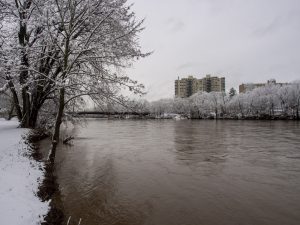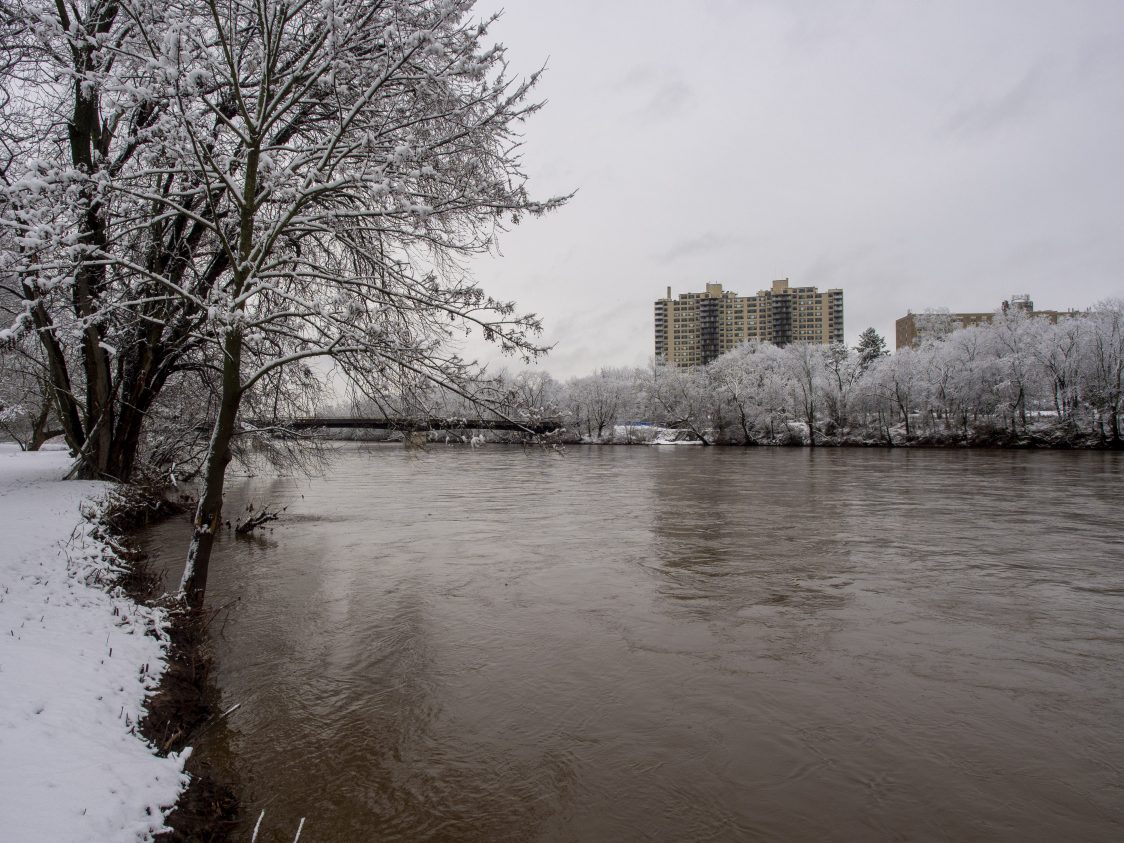Rutgers Cooperative Extension faculty member Michele Bakacs is leading an effort to study pathogens in the Raritan River, aiming to ensure the river eventually meets fishable and swimmable standards in New Jersey and becomes a resource that is cherished and celebrated.
By Carol Heher Peters

Photo by Matt Drews
On a sweltering day in May, Rutgers students gather on the banks of the sparkling Raritan River and wade into the clear water to swim. Further out, students in kayaks and canoes also enjoy cooling off on the river. Across the river in Highland Park, people swim and relax on the beaches at Donaldson Park.
This scenario is a fantasy, of course, but could such a future for the lower Raritan river ever exist? Rutgers Cooperative Extension faculty member Michele Bakacs, who is leading an effort to help restore the river, said it could. “The good news,” Bakacs said, “is we are finally getting data about pathogens in the Raritan River. For a long time, there was very little if any pathogen information about the Raritan. With the data we now have, we can finally start figuring out how to solve the problem.”
Bakacs is an associate professor in the Department of Agriculture and Natural Resources at the Rutgers School of Environmental and Biological Sciences, and she is a county agent with Rutgers Cooperative Extension, part of the New Jersey Agricultural Experiment Station.
She worked on the project with her community partner, Heather Fenyk, president of the Lower Raritan Watershed Partnership (LRWP). Partners on the project include Nicole Fahrenfeld, associate professor with the Department of Civil & Environmental Engineering, Institute of Earth, Ocean, and Atmospheric Sciences faculty member Richard G. Lathrop (Department of Ecology, Evolution & Natural Resources, SEBS), Jessica Bonamusa (Interstate Environmental Commission), Robert Buchanan (New York City Water Trail Association), and Jesse Stratowski (Rutgers Department of Recreation). The Interstate Environmental Commission provided lab services as well as quality assurance/quality control oversight through an EPA approved quality assurance project plan, training, and providing YSI monitoring sondes. The project received funding from the Rutgers Raritan River Consortium and also the Rutgers Research Council.
Bakacs said the effort to test the water and study pathogens (E-coli and Enterococcus), first began in 2019 when project partners worked with community volunteers to collect weekly pathogen samples for 20 weeks at six public access sites along the tidal portions of the Raritan River. Weekly sampling continued in 2020 although volunteers were not able to participate due to Covid.
The aim of their work, Bakacs said, was to collaborate with communities on the river to track down sources of these pathogens. “We are just establishing our data set, and it takes years to truly determine the water quality of a river. One snapshot is never a great way to determine what water quality is like. So, we want to be able to do this every year so we can have this long- term data set. We would also like to monitor the river for nitrogen and phosphorous and some other pollutants but all of that requires money and other resources.
“Our focus now is the public health perspective. We’d like to be able to tell people that the river is safe for recreation. For this reason, we make sure our results are immediately made available to the public through the LRWP’s website and the New York City Water Trail Association’s Citizen’s Water Quality Testing Program. That’s a big advantage of this project. Historically, when organizations collected data on the Raritan, it was kept on somebody’s private computer, and maybe it was made public a few months later. But we release our data the next day, so the public can check the water quality in real time to determine what activities are safe to do on the river that day.”
The data is also available (though it is not posted immediately) through the Raritan River Hydrological Observatory managed by EOAS faculty member Richard Lathrop, and it can also be accessed through the Rutgers Raritan River Consortium (R3C) website.
The data she and others have collected indicate that the lower Raritan River is more polluted than the northern branch, where the land is more forested. “Last year 73% of the water samples taken by the Rutgers boathouse in New Brunswick exceeded safe pathogen standards,” Bakacs said. “The standard for Enterococcus is 104 colony forming units and so 73% of the time when we took a sample it was above that standard. This standard is the standard the state uses to determine safe swimming.”
What are the sources of the pathogens in the Raritan River? Industries and landfills once located on the lower Raritan are not the source, Bakacs said, because that’s not how it works. Pollution from the industries and landfills that existed for centuries along the Raritan are known as legacy pollutants, and they can be found in the river sediment, and while they are a problem and need to be cleaned up, they are not the source of E-coli and Enterococcus.
Stormwater runoff is probably the likeliest reason for the high pathogen levels in the river, Bakacs said, explaining that the Lower Raritan River is a highly urbanized watershed and there are a lot of hard surfaces such as pavement near the river. During rainstorms, the rain that lands on the pavement and other surfaces, is directed – in other words is purposely designed to flow – into storm drains that flow right into the Raritan River.
Fortunately, she said, in March 2020 New Jersey adopted new regulations for stormwater systems. Bakacssaid, “The New Jersey Department of Environmental Protection (DEP) adopted amendments to their stormwater rules. Now we are into a new generation of stormwater management known as green infrastructure. This is designed to reduce stormwater at the source where it’s generated by using strategies such as rain gardens that soak up the water where it falls.”
However, Bakacs cautioned, “the revised DEP stormwater rules only apply to new developments, they do not take into account developments that are already in place. There are opportunities to retrofit older landscapes, but in the older parking lots, the stormwater will still go directly into the storm drains, and then into the river. These properties are grandfathered in.”
Stormwater problems aren’t their only concern, Bakacs said. Other sources of pathogens could be from waste produced by waterfowl, human waste contributed by broken sewer lines or homeless encampments on the River. Dog waste is also another big contributor, so it is essential for dog owners to pick up and dispose of pet waste properly.
“At the Perth Amboy site, one of our most downstream testing sites, there is a Combined Sewer Outflow (CSO). Anytime it rains, the CSO may discharge raw human sewage into the Raritan River, because that’s the nature of a CSO.” Bakacs said.
However, she said, the Perth Amboy CSO does not explain the levels of pathogens they’ve found at the Piscataway water testing site, which is upstream, very far from Perth Amboy. “Those two areas are so far apart they have nothing to do with each other, and yet we have found very high pathogen levels in Piscataway. We are not sure where they are coming from.”
While much of the work to improve the health of the river must be done by the state government and municipalities, Bakacs said there are many steps ordinary citizens can take to help clean up the river.
“Homeowner landscaping practices are definitely directly tied to water quality of the Raritan and local streams that feed into the Raritan, so private homeowners can help clean the Raritan by reducing the amount of fertilizer they use, and by helping to reduce storm water runoff on their properties by installing rain gardens. These will help soak up rainwater – keeping it out of the river. Rain gardens also provide great habitat, so they help create biodiversity. But even doing something as simple as just redirecting a downspout so rain soaks into the lawn rather than running off the driveway has proven to be very helpful.”
“Reducing lawn area is also effective. Lawns are great, but the trophy mega lawns are not great. If homeowners have that kind of lawn, they can reduce it by turning some of it into wildflower meadows or pollinator gardens. Lawns do not soak up rain, i.e., reduce stormwater runoff, in the same way that rain gardens or meadows or other similar habitats do. I recently heard the term, ‘think about modernizing your lawn.’ One of our Rutgers Environmental Stewards came up with that phrase, to capture the idea to ‘modernize your lawn to build habitat to improve ecology, instead of having an old-fashioned trophy lawn.’ Using permeable pavement on private property can help too, because that also helps reduce runoff. These are all river friendly practices.”
There is much we can all do to restore the Raritan to the point where state standards are met and we could swim in it safely, Bakacs said, adding that a great example is the Charles River in Boston. At one time, she said, the Charles was a very polluted river, but stakeholders have been successful cleaning it up and now it meets fishable and swimmable standards for Massachusetts.
“I was out on the Raritan River in a boat in October and it was so beautiful,” Bakacs said. “There was so much wildlife in the river. We saw turtles, herons, and schools or fish known as Bunker that were swimming upstream in the river. Cleaning up the Raritan so it is safe enough to swim in is definitely a goal I strive for. Wouldn’t it be wonderful if students on campus and townspeople could swim in it, and Rutgers embraced the river for the beauty and recreation it provides?”



